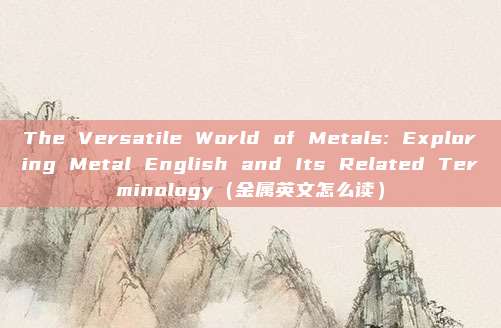The Versatile World of Metals: Exploring Metal English and Its Related Terminology(金属英文怎么读)
温馨提示:这篇文章已超过224天没有更新,请注意相关的内容是否还可用!
In the ever-evolving landscape of construction, manufacturing, and technology, metals have played a pivotal role in shaping our world. Metal English, the specialized terminology associated with metals, has become an essential language for professionals across various industries. This article delves into the world of Metal English, defining key terms and exploring their significance in the metallic realm.
Introduction to Metal English
Metal English refers to the technical jargon and vocabulary used to describe metals, their properties, and the processes involved in metalworking. It is a language that has evolved over centuries, influenced by the historical development of metal production and technology. Understanding Metal English is crucial for anyone involved in the metal industry, from engineers and metalworkers to buyers and suppliers.
Types of Metals

One of the first aspects of Metal English to grasp is the types of metals. There are two primary categories: ferrous and non-ferrous metals.
1、Ferrous Metals: These are metals that contain iron, the most common being steel and cast iron. Steel, often referred to as the backbone of modern construction, is known for its strength, durability, and versatility.
2、Non-Ferrous Metals: Unlike ferrous metals, non-ferrous metals do not contain iron. They include aluminum, copper, brass, bronze, and nickel. These metals are prized for their unique properties such as conductivity, corrosion resistance, and recyclability.
Properties of Metals
Metal English also encompasses a wide range of terms that describe the properties of metals. Some of the key properties include:
1、Malleability: The ability of a metal to be hammered or rolled into thin sheets without breaking. This property is particularly important in metalworking applications.
2、Ductility: The capacity of a metal to be drawn into a wire without breaking. Ductility is essential in the production of wires and cables.
3、Hardness: A measure of a metal's resistance to indentation and scratching. Hardness is a critical factor in the durability of metals used in construction and machinery.
4、Tensile Strength: The ability of a metal to withstand tension without breaking. Tensile strength is a fundamental property used to assess the load-bearing capacity of materials.
Metalworking Processes
The language of Metal English extends to the various processes involved in metalworking. Some common processes include:
1、Forging: The shaping of metal by applying pressure, often using hammers or presses.
2、Welding: The joining of metal pieces using heat, often using techniques like MIG (Metal Inert Gas) or TIG (Tungsten Inert Gas).
3、Casting: The process of pouring molten metal into a mold to create a solid object.
4、Extrusion: The process of forcing a heated metal billet through a die to create an object with a specific cross-sectional shape.
Industry Reports and Data
According to a report by MarketsandMarkets, the global metalworking machinery market is expected to grow at a CAGR of 4.2% from 2021 to 2026. This growth is driven by the increasing demand for precision metal components in various industries such as automotive, aerospace, and construction.
Conclusion
Metal English is a complex language that reflects the intricate world of metals. By understanding the terminology and concepts associated with metals, professionals can communicate more effectively, make informed decisions, and contribute to the advancement of metal-related industries. Whether you are an engineer, metalworker, or simply interested in the field, familiarizing yourself with Metal English will undoubtedly enhance your knowledge and appreciation for the metallic wonders that surround us.
网站文章、图片来源于网络,以不营利的目的分享经验知识,版权归原作者所有。如有侵权请联系删除!





还没有评论,来说两句吧...